The 1926 Silver Dollar belongs to the Peace Dollar Series, which only ran for a few years. These were struck nearly a century ago, so most coins have signs of wear. However, quite a few high grades are exhibiting superb luster and strike. Just be prepared to save an adequate sum, as it can sell for thousands of dollars, especially condition-rarity coins.
In this article, we’ll discuss everything you need to know about the 1926 Peace Dollar Value, including the die varieties and error coins available in the open market. But before that, here’s a summarized value chart including the mintage for each Mint location.
| Mint Location | Mintage | Coin Series | Estimated Value |
| Philadelphia | 1,939,000 | 1926 $1 Regular Strike | $28.50-$21,500 |
| Denver | 2,348,700 | 1926-D $1 Regular Strike | $28.50-$22,500 |
|
San Francisco |
6,980,000 |
1926-S $1 Regular Strike | $28.50-$40,000 |
| 1926-S $1 Prooflike | $82,500 |
1926 Peace Dollar Value History
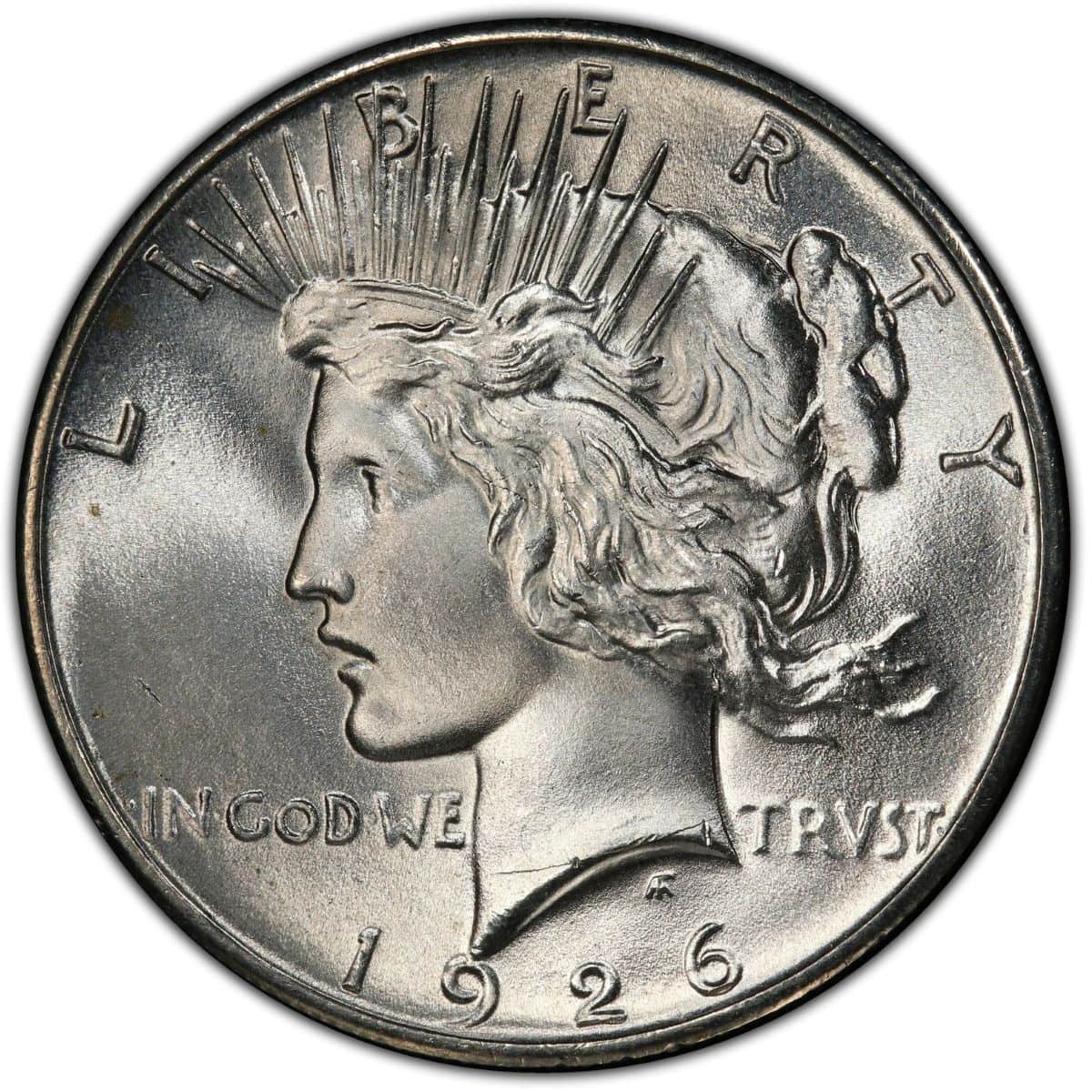
The world yearned for a time of peace and restoration after the horrific World War I. For the United States, their aspiration and hopes for a better future resulted in the creation of the Peace Dollar. The first circulation coin appeared in 1921, following the initial design of Anthony de Francisci.
But after six years, the 1926 Peace Dollar underwent a minimal revision in which the word GOD on the obverse side is slightly boldened. No exact Mint records state why it is the only word that changed in the motto IN GOD WE TRUST. However, experts assumed that the designer began working in the center of the clause to create the redesign.
The 1926 Peace Dollar is the 6th year in the series, contributing 11,267,700 from all three Mints. However, the combined amount is less than a fifth lower than the previous years, making it uncommon in circulation.
1926 Peace Dollar Coin Information
- Category: Peace Dollars (1921-1935)
- Face Value: One Dollar
- Obverse-Reverse Designer: Anthony de Francisci
- Metal Composition: 90% Silver, 10% Copper
- Weight: 26.73 grams
- Diameter: 38.10 millimeters
- Edge: Reeded
A few renowned artists, including V.D. Brenner and A.A. Weinman, submitted designs for the Peace Dollar, but Anthony de Francisci, an Italian immigrant, earned the affection of the federal Commission of Fine Arts.
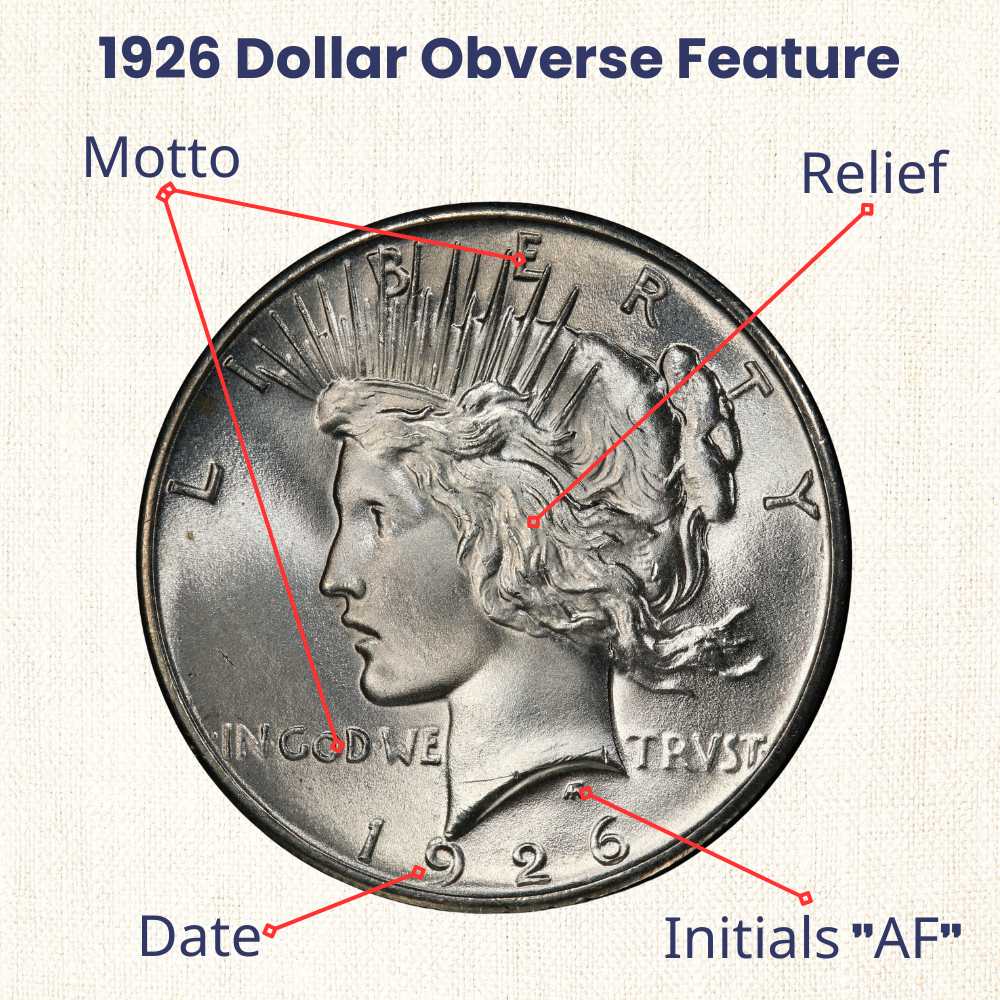
In his design, the portrait of Liberty, modeled by his wife, dominates the obverse side. Arched above the bust is the word LIBERTY, and below is the motto IN GOD WE TRUST and the Mint year. Lastly, his initials, AF, appear on the truncation of the neck.

On the reverse side is an eagle in a relaxed state, perched atop a crag, with the word PEACE located below. The word ONE DOLLAR is spaced beside the eagle, while the sunbeams extend from below and end before the text UNITED STATES OF AMERICA and E PLURIBUS UNUM.
You can locate the “D” or “S” mintmark on the reverse side, just below the letter O of the word ONE DOLLAR. If the coin has none, it is automatically considered a coin from the Philadelphia Mint.
1926 No Mintmark Peace Dollar Value
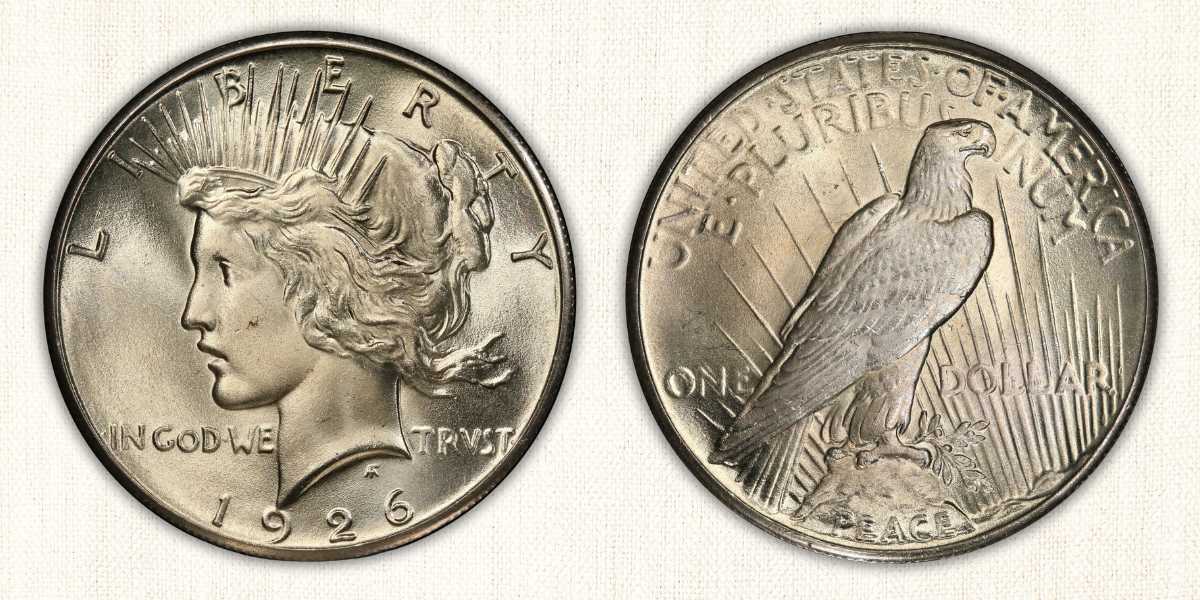
The Philadelphia Mint has a relatively low mintage, with only 1,939,000 pieces of 1926 Silver Dollar. Most that survived today are in worn grades through AU, with thousands of samples known to exist. Nonetheless, circulated grades can still sell between $29 to $70, a few dollars higher than the previously dated Peace Dollars.
On the other hand, Mint State conditions are scarce yet can be located without difficulty. The Treasury released hoards of this in 1944, enough for intermediate and advanced collectors. You can encounter at least one or two in the open market that are well-struck and have excellent luster. You can expect the uncirculated condition to sell anywhere from around $75 to $21,500.
| 1926 Peace Dollar Value Chart | |
| Coin Grade | Estimated Value |
| Good (G4) | $29 |
| Fine (F12) | $30 |
| Extremely Fine (XF40) | $31.50 |
| About Uncirculated (AU50) | $33.50-$34 |
| Uncirculated (MS60) | $75-$80 |
| Gem Uncirculated (MS65) | $550-$700 |
| Superb Gem Uncirculated (MS67) | $21,500 |
Most 1926 Peace dollars in Mint State have an attractive surface, and there are indeed MS-67 graded coins for this variety, which are highly valued. However, only three known samples appeared in the auction to date.
The first and the highest-sold MS-67 fetched a staggering $120,000 under Heritage Auctions in 2021. The coin has a flawless surface with a vibrant mint luster throughout, making it deserving of the title “Single-Finest Certified.”
Second to the list has a sale price of $14,950 sold in 2006, followed by $14,375 by Bowers & Merena in 2005.
1926-D Peace Dollar Value
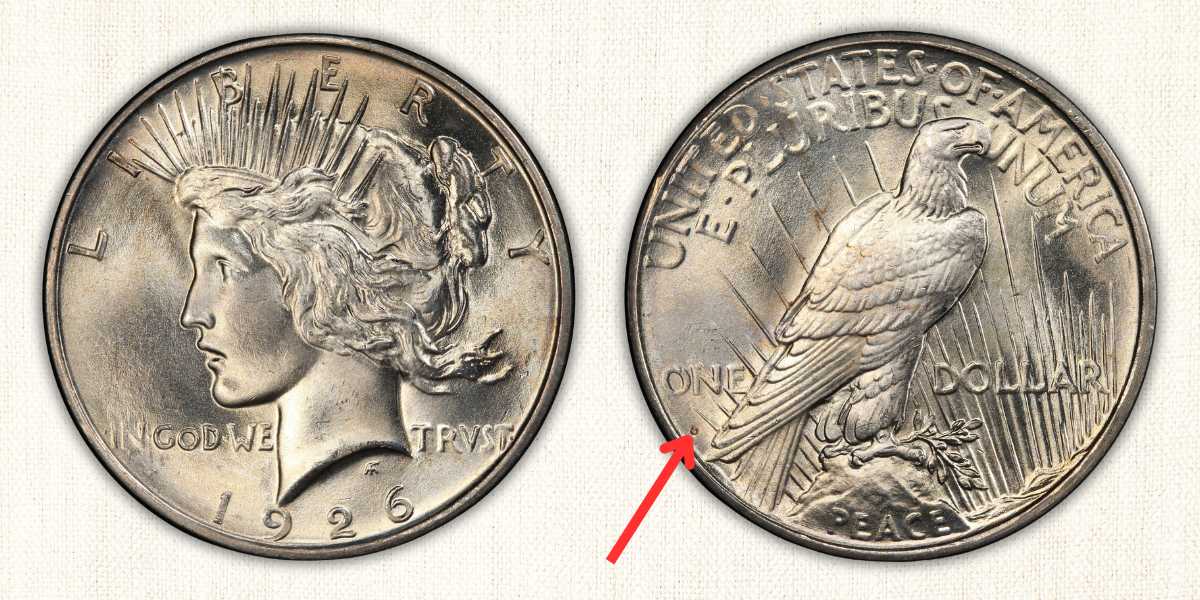
The Denver Mint produced 2,348,700 regular strike 1926 Silver Dollars, which is a higher mintage than that of the Philadelphia Mint. With a high number, those in Very Fine condition through About Uncirculated are common, with at least a thousand examples. Today, a circulated condition 1926-D is valued at around $29 to $110.
Conversely, those in the Mint State condition have slightly fewer examples. MS-64 is the most frequently seen grade, while MS-65 through MS-66 have less than a thousand specimens. Anything higher is considered rare and can fetch a premium.
With a moderate percentage of survival estimate, a 1926-D in uncirculated condition can sell for about $130 to $22,500.
| 1926-D Peace Dollar Value Chart | |
| Coin Grade | Estimated Value |
| Good (G4) | $29 |
| Fine (F12) | $30 |
| Extremely Fine (XF40) | $42.50 |
| About Uncirculated (AU50) | $50-$55 |
| Uncirculated (MS60) | $130-$140 |
| Gem Uncirculated (MS65) | $1,050-$1,750 |
| Superb Gem Uncirculated (MS67) | $22,500 |
The 1926-D Peace Dollar offers good strike characteristics and booming luster. It can be a good coin choice for type purposes since it is affordable. However, note that some D-marked samples have distracting die cracks that affect their value. Later, we’ll talk more about the error coins and their valuation.
But going back, the 1926-D MS-67 received high praise from coin researchers because of its powerful luster. This coin was sold for $47,000 by Heritage Auctions in 2015, and none surpassed the sale price in the following years.
1926-S Peace Dollar Value
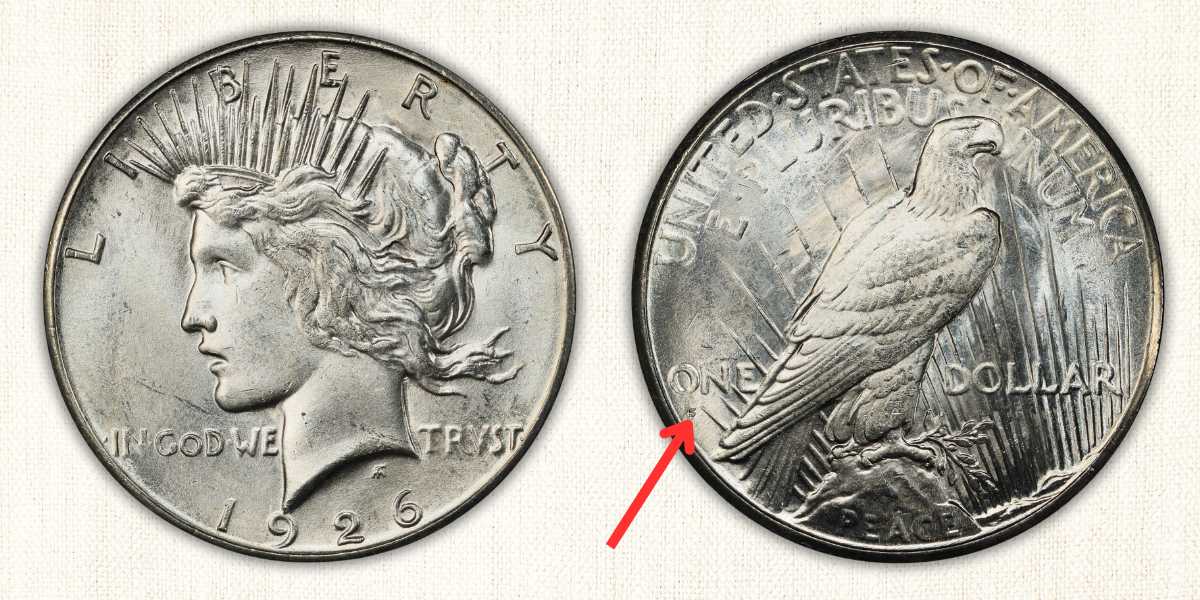
The San Francisco Mint produced a massive amount of 1926-S Silver Dollar, reaching 6,980,000. This high production made it relatively common today, with the majority of the certified samples falling into grades MS-63 and MS-64 categories. However, in MS-65, the survival estimates drop to less than a thousand, while MS-67 is a condition-rarity.
Currently, a circulated condition 1926-S is worth around $29 to $65, while an uncirculated condition can fetch $70 to $40,000. But if it has a Prooflike designation, you can expect it to reach $82,500.
| 1926-S Peace Dollar Value Chart | |
| Coin Grade | Estimated Value |
| Good (G4) | $29 |
| Fine (F12) | $30 |
| Extremely Fine (XF40) | $31.50 |
| About Uncirculated (AU50) | $40-$42.50 |
| Uncirculated (MS60) | $70-$80 |
| Gem Uncirculated (MS65) | $1,000-$1,400 |
| Superb Gem Uncirculated (MS67) | $40,000 |
The 1926-S Peace Dollar is the only S-mint issue with an excellent strike in the series. Additionally, its Mint luster ranges from frosty to brilliant. However, some have diminished eye appeal because of bag marks.
Bag marks became evident in this issue after casinos and banks released hoards of this 23 years later. Nonetheless, they still sell for thousands of dollars in open auctions.
An example is this MS-66+ sold for a whopping $41,125 by Legend Rare Coin Auctions in 2019.
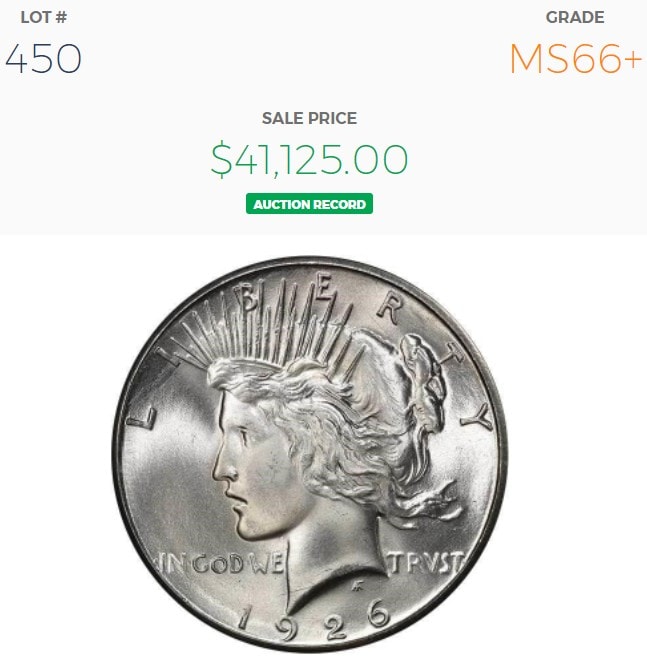
The MS-67 also has a single appearance on the record and has a sale price of $32,300 sold by Heritage Auctions in 2011.
1926 VAM Peace Dollar Die Varieties
If you’re collecting Morgan or Peace silver dollars, high chances are you’ve heard about VAM. But if you haven’t, let’s briefly talk about it before we mention some die varieties from this issue.
VAM is the initial of the researchers—L.C. Van Allen and A.G. Mallis—who photographed and cataloged the different die varieties in the Morgan and Peace silver dollar series. Some differences can be seen with the naked eye, while others may require a loupe or coin microscope.
So, how do VAMs come to life? The first possible cause of a die variety is during the production process when the Mint worker causes unintentional minor errors to the coin. The second is during coin maintenance when the Mint workers try to extend the coin’s life by removing the error. However, this can result in slight variations to the design.
Now—let’s tackle the top three die varieties among the 11 discovered in the 1926 silver dollar.
1. 1926 VAM 2 Doubled Reverse
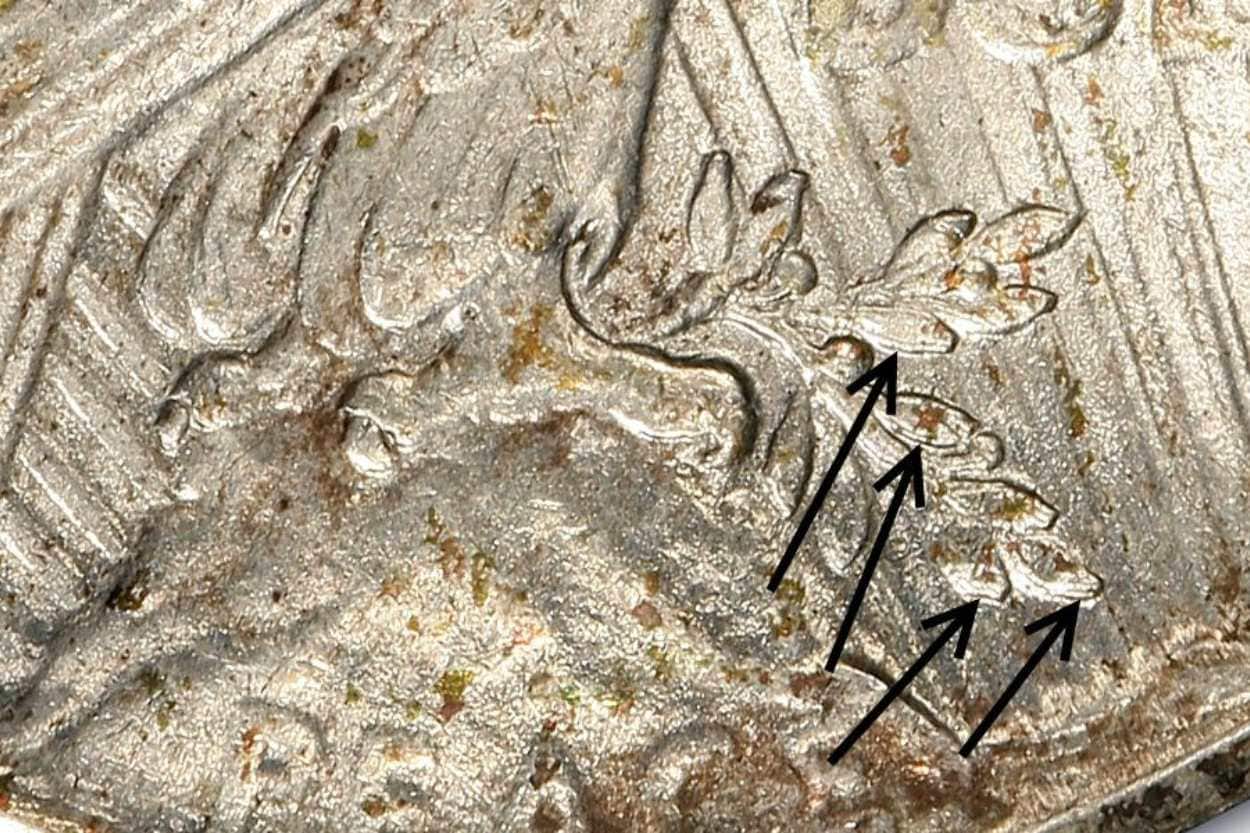
The doubling for this die variety is evident on the olive branch clutched by the eagle on the reverse side of the coion. The highest auction record for this die variety fetched $5,520 sold by Heritage Auctions in 2022.
2. 1926-S VAM 4 Dot Variety
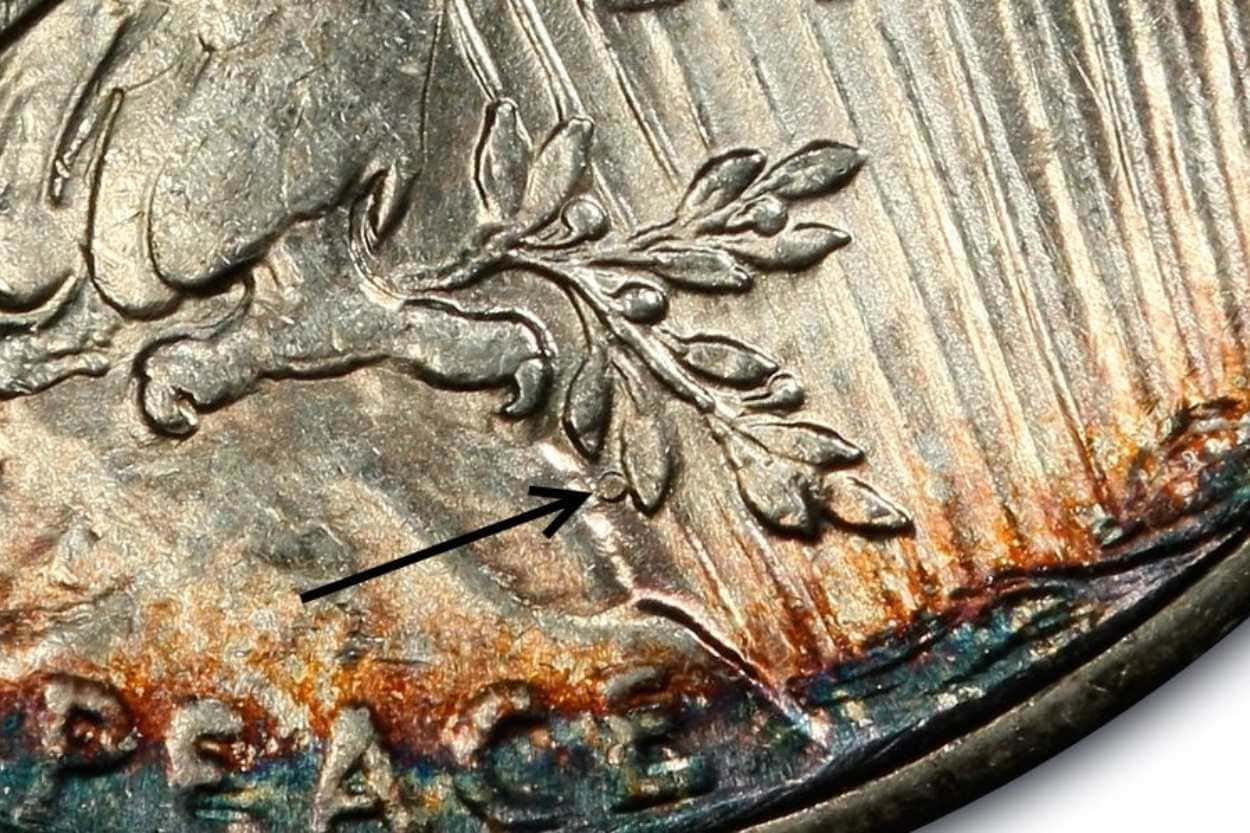
Here is an excellent sample of die variety with minimal difference yet is visible by an unaided eye. On the reverse side, you’ll notice a small dot between the rock and the olive leaf. The highest grade for this die variety is an MS-65, and it sold for $960 under Heritage Auctions in 2020.
3. 1926-S VAM 5 Doubled Reverse
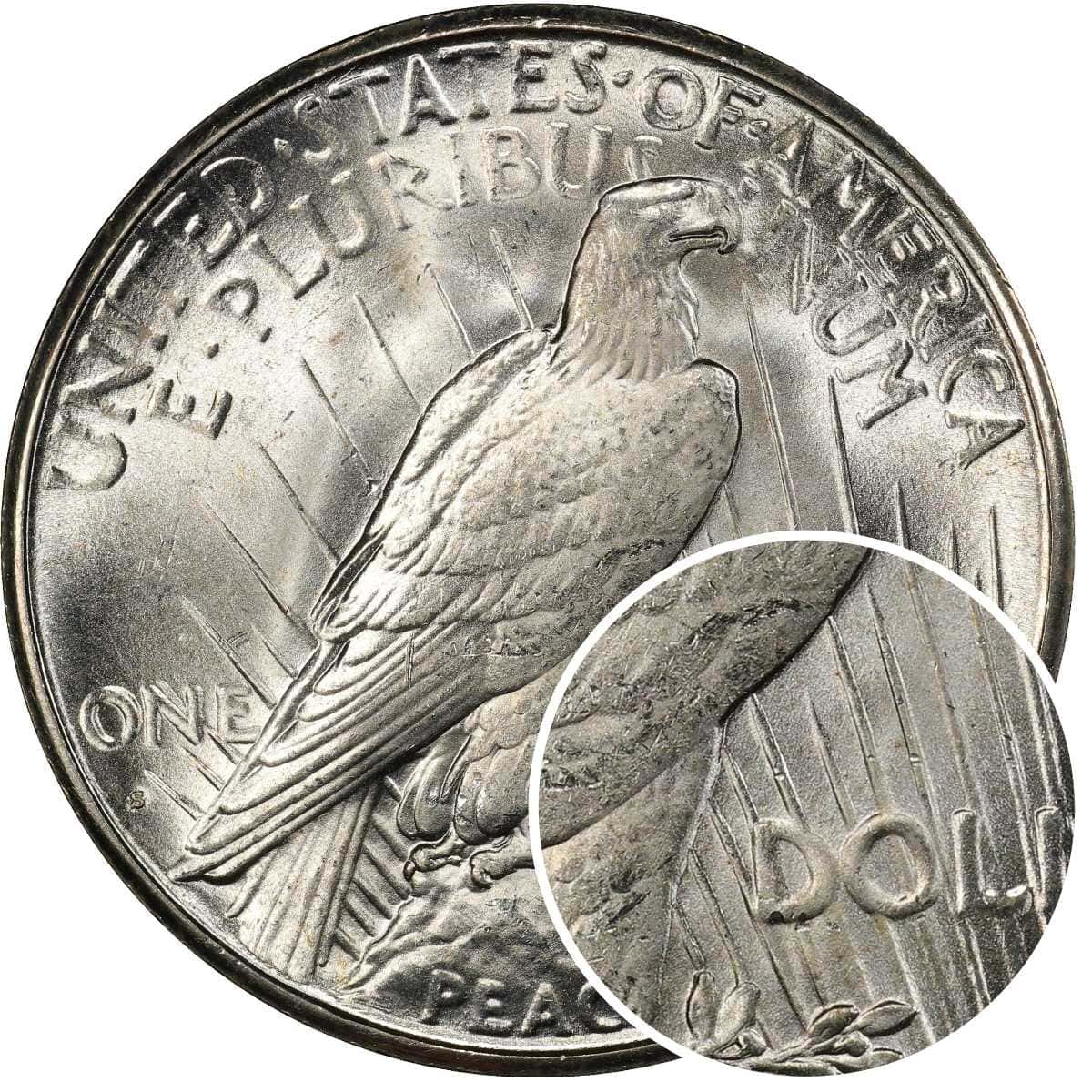
Coming in third is also a double reverse, but this time, the doubling is more prominent on the eagle, the words ONE DOLLAR and OF AMERICA. The highest sale price for this variety reached $750 for an AU-58 condition in 2019.
1926 Silver Dollar Error Coins
Error coins differ from die varieties in the sense that most are unique to that particular denomination. Die varieties repeat on each coin struck, but error coins have distinguishing characteristics that may or may not increase the coin value. Errors happen at any time in the manufacturing process. It could be a poor metal mixture, strike issues, or planchet errors.
Below are some examples we’ve seen on the market today, including their current value.
1926 $1 Minor Struck Thru Obverse Error

Missing design elements can occur when there are tilted dies or because a foreign material plugs into the die cavity. But for this case, a struck-through dense material, like grease, causes the number 1 to disappear.
Circulated conditions with this error type can sell between $35 to $100, but Mint State grades can fetch hundreds of dollars.
1926 $1 Defective Planchet Error

A defective planchet can result in a wide variety of coin errors. It can happen before striking or during the planchet-making process. Sometimes, it would cause a small hole in any part of the coin, giving it a dramatic effect unique to others.
Those with slight defects can sell for over $30, while those with blow holes can fetch over a thousand dollars.
1926 $1 Die Crack Error
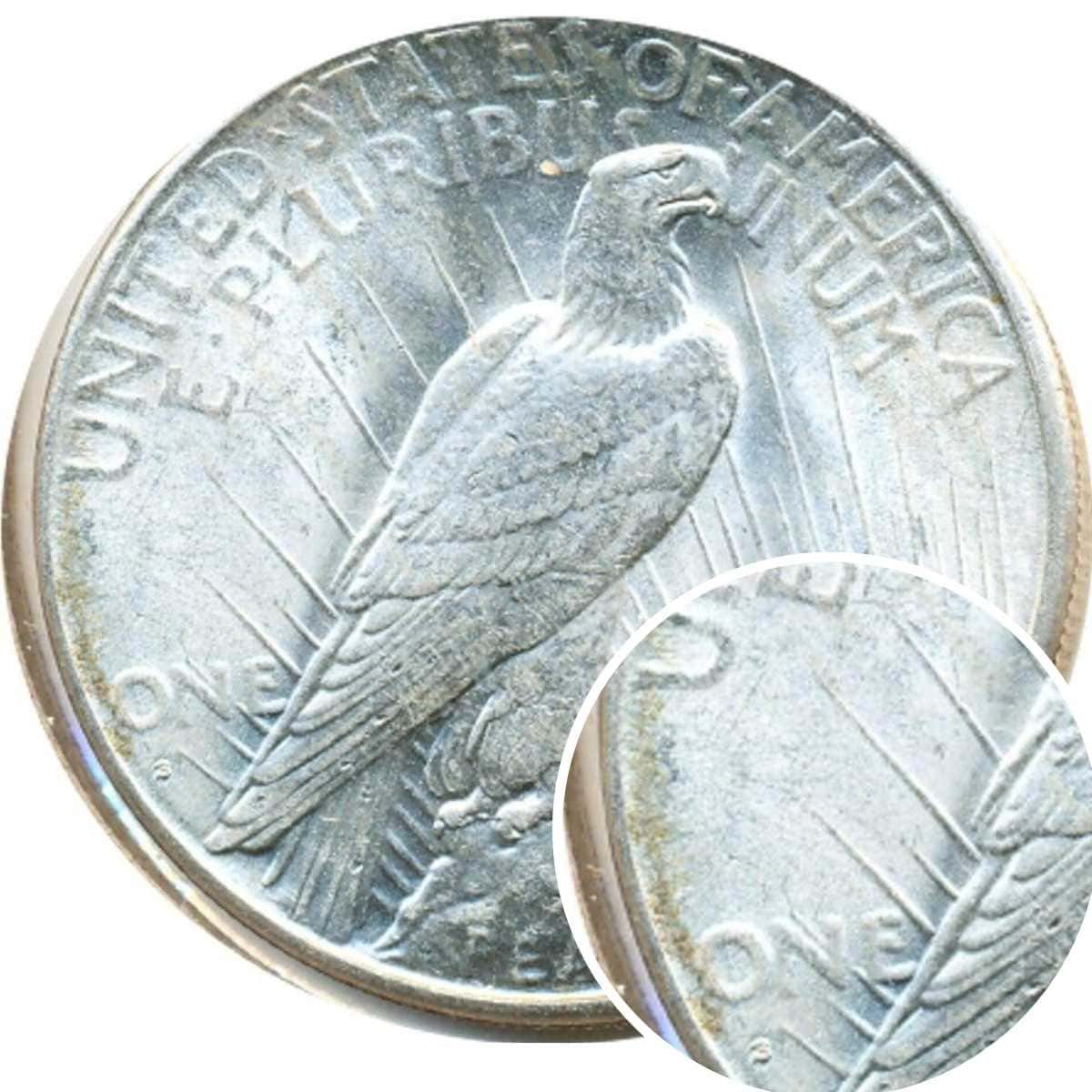
Dies can crack after prolonged use and cause a raised surface on the struck coins. An example is this 1926-S Peace Dollar with a die crack running from the letter U of the word UNITED towards the mintmark. However, the raised marks are a bit faint due to the high reflection of the field upon scanning the coin.
Peace silver dollars with this error type can sell from $50 to thousands of dollars.
1926 $1 Reverse Lamination Error

Lamination error is a planchet defect that roots from metal impurities or internal stresses. It causes cracks, uneven surfaces, or peeling on the coin. Here, you’ll notice a small crevice crossing through the eagle’s tail feather.
A Peace Silver Dollar with this type of error can sell for a few hundred to a thousand dollars, depending on the coin’s condition.
1926 $1 Reverse Misaligned Die

Perfect coins require proper hammer and anvil die alignment. However, if the die is slightly tilted, offset, or rotated, it can cause discrepancies in the design. For this specific coin, it is a possible tilting error since it is thinner on one edge, but the obverse side is centered.
This specific coin with a grade of AU58 sells for $350, but you can expect it to sell for higher if in uncirculated condition.
What Year is The Rarest in The Peace Dollar Series?
The 1928 Peace Dollar has the lowest mintage of business strike dollars among the series. The Philadelphia Mint was only able to produce 360,649 pieces of 1928 silver dollars, making it a key date.
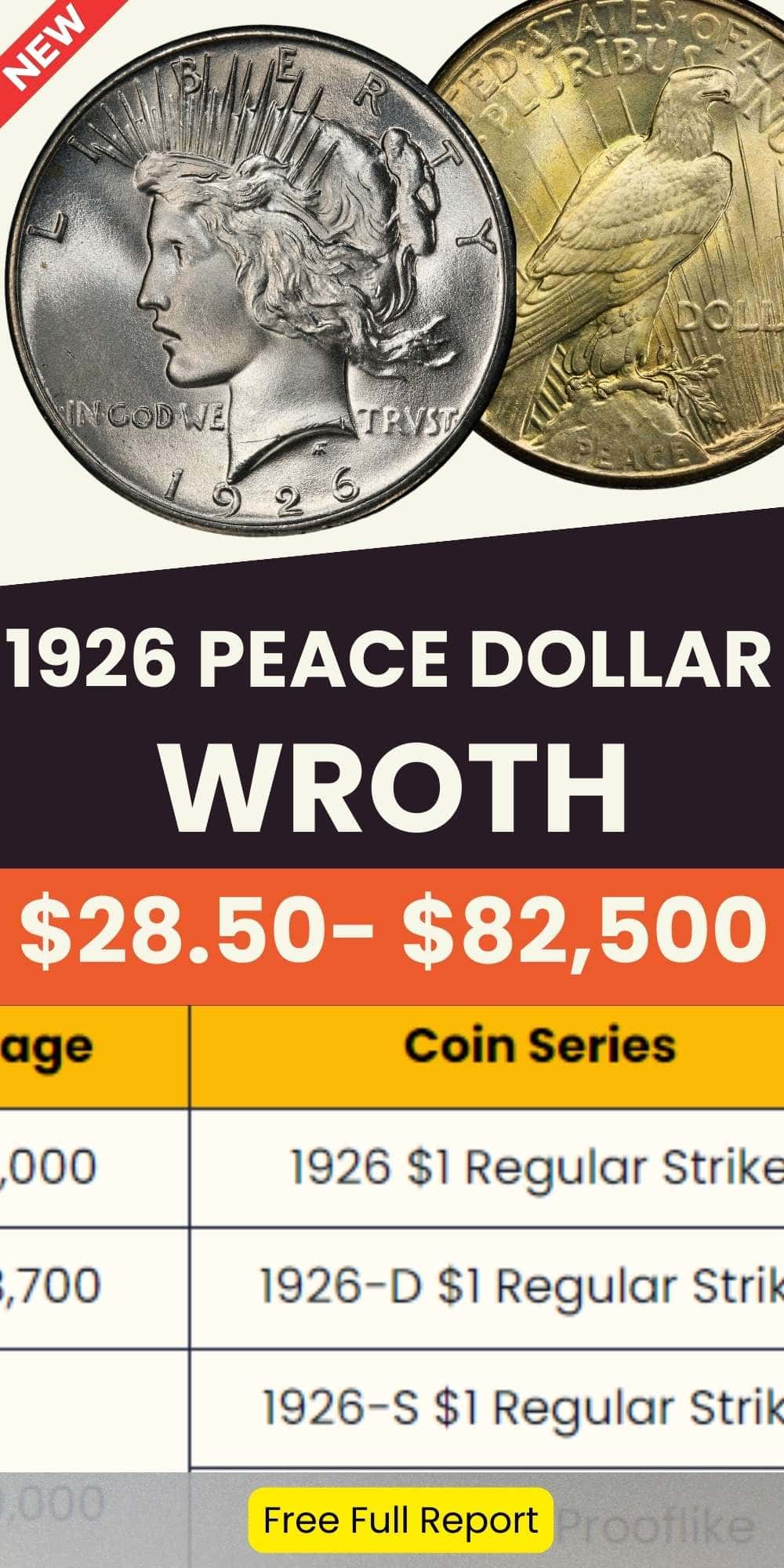

Jenson is a professional numismatist, a dedicated coin collector, a graduate of the College of Business at Oregon State, a life member of the American Numismatic Association (ANA), and an overall coin nerd. He is the founder of Coin Value List.
